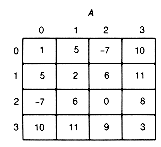int a[5][3];
defines a two-dimensional array of 5 ?/FONT> 3 or 15 entries, each of type integer. This array a can also be viewed as a collection of 5 one-dimensional arrays, each of length 3, or 3 one-dimensional arrays, each of length 5. Again, we can think of two variables i and j of the correct index type as pointing to an entry of the array. Thus a[i][j] refers to the entry of the ith row and jth column, or to the entry of a currently pointed to by i and j. We assume that the (i,j)th entry can be accessed in constant time, no matter what the value of i or j . That is, the (i,j)th entry may be selected. Traversal of two-dimensional arrays is also easy.
A two-dimensional array is symmetric if a[i][j] and a[j][i] contain the same value for all i and j between 0 and n - 1. Suppose a collection of n2 numbers, representing the distances between n(?/FONT>50) cities, is stored in a two-dimensional array a. Thus a[i][j] contains the distance between city i and city j. For this example, which involves distances, the array must be symmetric. However, the array a shown in Figure 2.4 is not symmetric, because a[2][3] does not equal a[3][2]. The n entries a[0][0], a[1][1],..., a[n - 1][n - 1] are called its diagonal entries. In the city-distance array, the diagonal entries must, of course, be zero.
Example 2.3
Suppose a programmer wished, perhaps as part of an input validation function for the data of an array, to check the array for symmetry. The programmer might choose to write a function check to return the value true if the array is symmetric and false otherwise. A simple traversal, as follows, will do the checking. n

Figure 2.4 An Asymmetric Two-Dimensional Array
typedef int collection[50][50];
check(a,n)
/* Returns true only if the first n
rows and columns of a represent
a symmetric array
*/
collection a;
int n;
{int i,j,ck;
ck = TRUE;
for (i = 0; i<n; i++)
for (j = 0; j<n; j++)
if (a[i][j] != a[j][i])
ck = FALSE;
return(ck);
}